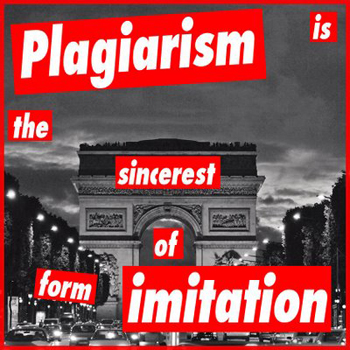
If appropriation is the highest form of flattery, then I love this Barbara Kruger Photoshop Tutorial. Of course it couldn’t be called plagiarism because there is no such thing in the art world, is there? We shall pick up this thread another time. In the interim, compare a Damien Hirst spin painting to one done by Alfons Schilling, made fifty years ago! Quite the spinning image.
It has been steady entertainment reading the numerous takes on the Hirst sale at Sotheby’s, from Robert Hughes’ evisceration of the “simple-minded” works to Ben Street’s less fuming Letter from London. Guardian writer Carol Jacobi even chimes in that Hirst is merely following in the footsteps of the 19th-century William Holman Hunt, comparing the AYBA’s (Aging Young British Artist) sidestepping of his galleries to the pre-Raphaelite painter’s circumvention of the Royal Academy of 1866.
Net take home pay aside, what I find truly staggering in all this is Hirst’s immense production. All 223 of the lots were dated 2008! According to my math, that’s almost one a day so far, and probably a count of many more considering there must be a few formaldehyde lemons laying around the shop. Holman Hunt, in contrast, sold one painting that he had been working on for six years.
It takes money to make money, or at least hire a massive studio. It might be fascinating to compare the Hirst crew to those of other historically prodigious outputters like Man Ray, the Warhol factory or Peter Paul Rubens. Though a more adequate analogy might be stickered to the hyper-paid athletes from the NBA or major league baseball. But the market cannot be faulted for giving the fans what they want. One feeds the other after all, and Michael Jordan would not be the same without his classic Air Jordans.
However, the true defining excess of the contemporary art market is not the crazy prices that living artists are commanding—better artists than philistines, I say—but rather the production costs of their works. Remember the $4.1 million (this is not a misprint) tab for Ai Wei Wei’s Fairytale project at Documenta? Notice the difference in production and prop value from Matthew Barney’s first Cremaster (Cremaster 4) to the last (Cremaster 3)? Long gone are the romanticized notions of a Basquiat squatting in his gallerist’s basement, making do with cheap paints and canvases while churning out masterpieces. Nowadays artists are setting up Motor City-like studios overnight, with a host of live-in assistants grinding pigments around the clock. And this is by no means a bad thing.
What I saw and what I’d like to see…a reality television show called Budget Swap in which two artists–one with a studio of 50 assistants and the other with 50 bucks to his name—test their creative mettle by flip-flopping their production budgets for three months. The artists would share other equivalent variables such as educational background and aesthetic philosophy, in order to even the playing field while isolating the $ factor. What works would come as a result and how would this inform the state of creativity and its indebtedness to production’s coffers, if anything? Or will the cream of the crop always have its say?